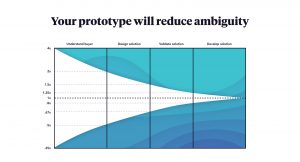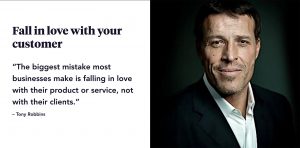
7 min read
Winning Digital Product Design: Kevin Hurwitz & Deanna Dial talk design tactics on new product development
Winning Digital Product Design: Kevin Hurwitz & Deanna Dial talk design tactics on new product development
Praxent Managing Partner Kevin Hurwitz and Principal of Product Strategy, Deanna Dial recently sat down with me for a live webinar on how to automate complex sales processes. They answered questions on creating persona definitions and user testing, among other related topics. Watch the full webinar on-demand here.
Here is a recap of our conversation.
Q: Do you recommend involving users in the design stage? Where do you bring them in?
Deanna: I view it as critically important to involve users in the design phase. If we think back to the cone of uncertainty, you’re talking to users at the very beginning. You are understanding your buyer and defining their personas. You’ll want to do some generative research, like sitting in and observing your customers. That should come before design.

There’s not a lot of value in spinning your wheels without getting that customer perspective, in my opinion.
Kevin: A lot of times we hear concerns from our clients such as: ‘Our customers do not know what they need. Our prospective buyers could not tell you what would make their lives easier.’ That often reminds us of a Henry Ford quote: “If I asked my customers what they wanted, they would have said ‘faster horses’.”
A lot of our clients look at that and say ‘Isn’t it our job to innovate? Isn’t it the case that our customers don’t know what they need? That’s my job to bring that value.’ Contextual observation, however, is critical. What if you were trying to create a better vending machine? You could ask the customer ‘What new features would make a better vending machine?’ You would probably get some really bad ideas. What if, instead, you sat next to the vending machine and watched people use it for an afternoon? If you are careful, paying attention, and make the effort to involve your users, you are likely to produce some real gold.
Q: How long does user testing take to complete?
Deanna: There are simple ways to get feedback really quickly. There are a lot of online mechanisms like Google surveys or UserTesting.com, where you can get feedback from a myriad of users in a few hours. If you want to do something more in-depth, you need the right buyers and the right circumstance. That can take longer.
Experienced design firms like Praxent can help facilitate user testing. Statistically significant user testing can take place in 4-6 weeks. In the scheme of things for you and your business, user testing does not take a long time, particularly compared to the time you could waste building and launching the wrong product.

Kevin: Across all products (not just in the space of sales automation), Clayton Christensen estimates that 95 percent of new product launches fail. This was based on his research. People assume the mountain they have to scale is just making it work, a software construction problem. ‘If I make it work, I win’. For these kinds of tools, however, they are almost always ‘tools of choice’. Your customers will use an alternative if your technology is hard to understand or doesn’t meet their needs. You could make it work and still get less than 5% of your target audience to use it. It is really hard to generate an ROI if only a tiny segment of your customers actually use what you built.
Q: Where do you get information to define personas?
Deanna: It’s a little art and a little science. Think of your first attempt as being provisional or draft format. If you have data on existing customers, you can start there. You could figure out different cohorts based on business size, number of employees, or job titles. You could segment your existing user base and see if there is any gold left in those mines.
Another possibility is to look at competitive products and market share analysis to figure out what types of people are using competitive products. Ideally, you want to go out and find some validation. Talk to those people and see if they fit your target market.
Another is trial and error. You might segment on business size and then prepare a survey that addresses a few key concerns. You could then analyze those results to see who fits into your target market. These are just a few ideas on getting the information to validate a persona.

Q: How much do you budget to bring somebody in to help with your user testing and persona definition?
Kevin: It varies quite a bit, based on the activities you need to perform. It also depends on how you break up the responsibilities between you and your partner. There is a lot an organization can do on their own. I cannot speak for the entire market, but for the clients we work with, we typically recommend they allocate between $20,000 and $50,000 for this kind of work. Obviously, the depth and detail of the work would depend on the budget.
Q: If someone wanted to build their product, what kind of team members do they need? Or, what should they be looking for in a partner?
Deanna: One school of thought comes from Google Ventures. They wrote a book called Design Sprint that is still popular among designers. They recommend involving key portions of the staff, including the CEO, head of marketing, head of product, and head of technology. This would help ensure there is a lot of buy-in to the direction. Interviewing stakeholders to get a coherent internal perspective is important.
At Praxent, we include multiple perspectives in a product team to drive the best outcome. We have a user experience professional who focuses on user research efforts. We also include a UI designer. They leverage user research insights to create a prototype. You also want to include people from your development staff, and your lead architect. You want someone who understands how your systems work today, or how they need to work in the future.
There is a lot of value in building on ideas within a group setting. My recommendation is to include as many people as feasible. At a minimum, you want to make sure your key stakeholders are included up front.
Kevin: This is not just one brilliant guy or gal knocking something out. A cross-functional approach is needed in today’s competitive digital landscape to be competitive.



Leave a Reply